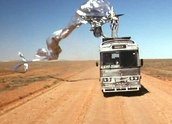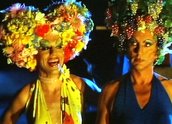


The Adventures of Priscilla, Queen of the Desert (1994)
Synopsis
‘Tick’ Belrose, aka Mitzi Del Bra (Hugo Weaving), a Sydney drag artist, accepts an invitation from his ex-wife (Sarah Chadwick) to bring his stage show to the outback. Tick recruits two friends – a brash young drag queen called Felicia (Guy Pearce) and an aging transgender woman called Bernadette (Terence Stamp). They set off for Alice Springs in a second-hand bus they dub ‘Priscilla, Queen of the Desert’. They turn heads in Broken Hill and get in a fight at Coober Pedy; they are rescued from break down in the desert by an open-minded mechanic (Bill Hunter). In Alice Springs, Tick meets the young son he barely knows (Mark Holmes). The three performers climb Kings Canyon in full drag, before making their stunning debut at the Alice Springs casino.
Curator’s notes
Australian cinema in the 1990s was somewhat obsessed with attempts to broaden depictions of Australian society, to redefine ‘who we are’. The masculine stereotypes of the 1970s and 80s were a particular target in films such as Strictly Ballroom (1992), Muriel’s Wedding, The Sum of Us and The Adventures of Priscilla, Queen of the Desert. These last three all came out in 1994, and although Muriel’s Wedding has no gay characters per se, it fitted into the new camp aesthetic that Strictly Ballroom had begun to explore.
The Adventures of Priscilla, Queen of the Desert went further than any of these in attacking the Crocodile Dundee mythology of the essentially harmless heterosexual outback male. These same types of men, usually depicted in bars in Priscilla, can be suspicious, violent, vulgar and extremely intolerant, especially when confronted with alternative definitions of masculinity.
The film’s cultural masterstroke was to impose an extreme aesthetic of artificiality (the drag queens) on a natural desert landscape of equal extremity. The surprise discovery for audiences was how well they matched. The film is intended as a rebirth of the musical, a road movie comedy, but its most unforgettable scenes work off the incongruity of seeing excessive costumes, on incongruous characters, in vast, humbling spaces. That’s why the film’s real climax is the climb up Kings Canyon in full drag, rather than the debut act at the casino. That’s also why the most welcoming response they get on tour is from a group of Aborigines, having a party around a campfire.
The film insists upon the naturalness of its characters, despite their ‘unnatural’ appearance, even more than the obvious idea that this is a union of two groups with a common oppressor. The demand for tolerance wasn’t uniformly applied though: the film was controversial for the way it depicted an Asian woman. Bill Hunter’s character may be the generous and open-minded face of the ocker male, but his mail-order wife, a Filipino prostitute given to drunken lewdness for the blokes in the bar, was denounced as a hideous stereotype, with good reason. She was never really a character to begin with – simply a way of suggesting the craziness of the men she entertains, who’d rather look at a heterosexual humiliation, than a homosexual exaggeration. Given the film’s fantastic sense of fun throughout, defining one character by racial stereotype was a blight on an otherwise broad sense of humanity. The film was a phenomenal success around the world, and particularly in Australia. The costume design, by Lizzy Gardiner and Tim Chappel, won an Oscar.
- Overview
- Curator’s notes
- Video 3 clips

- Principal credits
- Find a copy
- Comments 2
- Map
- Add your review



